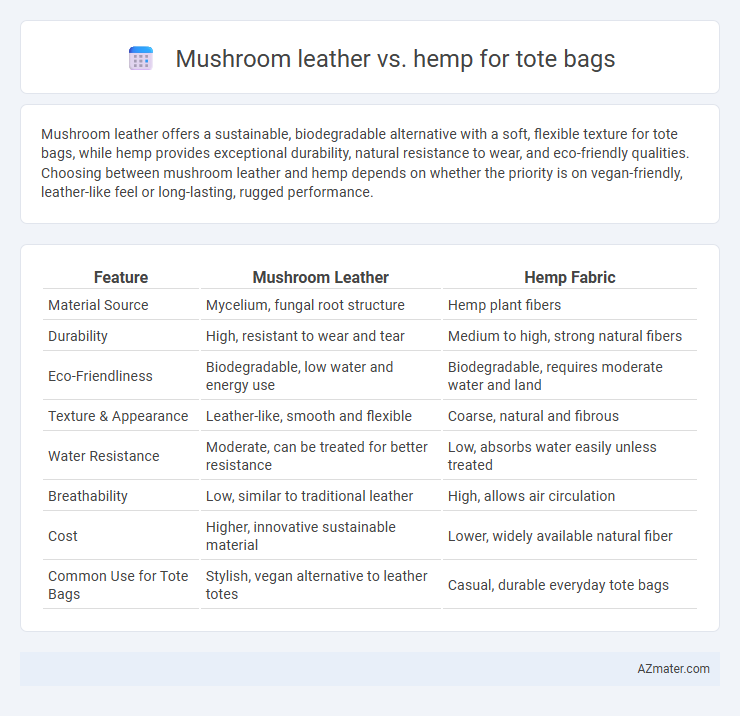Mushroom leather offers a sustainable, biodegradable alternative with a soft, flexible texture for tote bags, while hemp provides exceptional durability, natural resistance to wear, and eco-friendly qualities. Choosing between mushroom leather and hemp depends on whether the priority is on vegan-friendly, leather-like feel or long-lasting, rugged performance.
Table of Comparison
| Feature | Mushroom Leather | Hemp Fabric |
|---|---|---|
| Material Source | Mycelium, fungal root structure | Hemp plant fibers |
| Durability | High, resistant to wear and tear | Medium to high, strong natural fibers |
| Eco-Friendliness | Biodegradable, low water and energy use | Biodegradable, requires moderate water and land |
| Texture & Appearance | Leather-like, smooth and flexible | Coarse, natural and fibrous |
| Water Resistance | Moderate, can be treated for better resistance | Low, absorbs water easily unless treated |
| Breathability | Low, similar to traditional leather | High, allows air circulation |
| Cost | Higher, innovative sustainable material | Lower, widely available natural fiber |
| Common Use for Tote Bags | Stylish, vegan alternative to leather totes | Casual, durable everyday tote bags |
Introduction: The Rise of Sustainable Tote Bag Materials
Mushroom leather and hemp have emerged as innovative sustainable materials for tote bags, offering eco-friendly alternatives to traditional leather and synthetic fabrics. Mushroom leather, derived from mycelium, boasts a biodegradable and vegan profile with a soft texture that mimics real leather. Hemp is prized for its durability, natural resistance to wear, and low environmental impact due to minimal water and pesticide requirements, making both materials ideal for environmentally conscious consumers.
What is Mushroom Leather?
Mushroom leather, also known as mycelium leather, is an eco-friendly, sustainable material derived from the root structure of fungi called mycelium. This biodegradable alternative mimics the texture and durability of traditional leather while requiring significantly less water and energy to produce. Mushroom leather offers a cruelty-free option for tote bags, combining natural aesthetics with environmental responsibility.
Understanding Hemp as a Textile
Hemp fabric, derived from the fibers of the Cannabis sativa plant, offers exceptional durability and breathability, making it an ideal choice for tote bags. Its natural resistance to mold and UV light enhances the longevity of hemp tote bags compared to mushroom leather, which, while eco-friendly, may be more susceptible to wear and moisture. Hemp's renewable cultivation process contributes to its sustainability profile, requiring fewer pesticides and less water than traditional textiles, ensuring an environmentally responsible material for everyday accessories.
Environmental Impact: Mushroom Leather vs Hemp
Mushroom leather, derived from sustainable mycelium growth, boasts a lower carbon footprint and biodegrades more rapidly than traditional leather, reducing landfill waste. Hemp, a fast-growing crop requiring minimal pesticides and water, offers strong fiber durability with exceptional soil regeneration properties that enhance agricultural sustainability. Both materials present eco-friendly alternatives to conventional leather, but hemp's carbon sequestration and mushroom leather's minimal processing energy highlight distinct environmental advantages.
Durability and Longevity Comparison
Mushroom leather, crafted from mycelium, offers impressive durability with natural resistance to wear and tear, making it a sustainable yet sturdy option for tote bags. Hemp fabric, known for its exceptional tensile strength and abrasion resistance, provides long-lasting durability and becomes softer with use while maintaining structural integrity. While mushroom leather delivers a unique, eco-friendly aesthetic with moderate lifespan, hemp totes typically outlast due to their robust fiber composition and resistance to environmental factors like UV exposure and moisture.
Aesthetic Appeal and Texture Differences
Mushroom leather offers a smooth, supple texture with a natural matte finish that mimics traditional leather, providing a luxurious and modern aesthetic for tote bags. Hemp features a coarser, fibrous texture with visible weaves that create a rustic, earthy look, appealing to those who prefer a more organic and rugged style. The choice between mushroom leather and hemp hinges on whether a refined, leathery appearance or a textured, natural fabric is desired for the tote bag's design.
Production Processes and Scalability
Mushroom leather, derived from mycelium, involves a biofabrication process that requires controlled growth environments and several weeks for full development, making scalability dependent on optimizing fungal cultivation techniques. Hemp, cultivated as a fast-growing plant, features a more established large-scale industrial harvesting and processing infrastructure, enabling higher production volumes for tote bags with lower resource input. Both materials offer sustainable alternatives, but hemp's proven agricultural scalability contrasts with mushroom leather's emerging biofabrication innovations.
Cost Analysis: Which is More Affordable?
Mushroom leather, derived from mycelium, often incurs higher production costs due to specialized fermentation processes, making it generally more expensive than hemp. Hemp, a fast-growing plant requiring minimal pesticides and water, offers a more cost-effective raw material for tote bags with scalable farming and processing methods. When considering affordability, hemp remains the preferred choice for budget-conscious consumers seeking durable and eco-friendly tote bags.
Consumer Preferences and Trends
Mushroom leather offers a sustainable, vegan-friendly alternative with a soft texture and earthy aesthetic that appeals to eco-conscious consumers seeking cruelty-free fashion. Hemp, valued for its durability and natural fibers, attracts buyers prioritizing longevity and organic materials in tote bags. Trends show a growing preference for mushroom leather among younger, trend-driven consumers, while hemp maintains steady popularity for its traditional, robust qualities.
Future Outlook: The Best Material for Eco-Friendly Tote Bags
Mushroom leather, derived from sustainable mycelium, offers a biodegradable and renewable alternative with a lower environmental footprint compared to traditional leather, positioning it as a promising material for eco-friendly tote bags. Hemp, known for its fast-growing nature and minimal need for pesticides, provides durability and strong fiber quality, making it an enduring choice for sustainable fashion. Future trends indicate mushroom leather's innovative appeal combined with hemp's proven ecological benefits will drive the market toward hybrid or integrated use for optimal eco-friendly tote bag solutions.

Infographic: Mushroom leather vs Hemp for Tote bag
 azmater.com
azmater.com